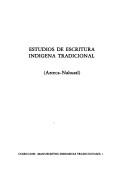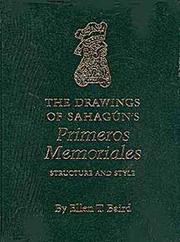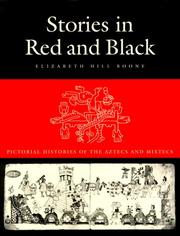| Listing 1 - 7 of 7 |
Sort by
|

ISBN: 968805044X 9791036540134 Year: 2019 Volume: 1 Publisher: Mexico : Centro de estudios mexicanos y centroamericanos,
Abstract | Keywords | Export | Availability | Bookmark
 Loading...
Loading...Choose an application
- Reference Manager
- EndNote
- RefWorks (Direct export to RefWorks)
Nahuatl language --- Indians of Mexico --- Aztèques --- Langues indiennes d'Amérique --- Writing. --- Languages --- Writing --- Ecriture --- Aztec hieroglyphics --- Aztecs --- Hieroglyphics, Aztec --- Picture-writing, Aztec --- Tlaxcalan Indians --- náhuatl --- escritura --- lingüística --- codex
Book
ISBN: 9791036540066 9686029664 Year: 2019 Publisher: Mexico : Centro de estudios mexicanos y centroamericanos,
Abstract | Keywords | Export | Availability | Bookmark
 Loading...
Loading...Choose an application
- Reference Manager
- EndNote
- RefWorks (Direct export to RefWorks)
Cet ouvrage est une contribution à l'étude des pictographies aztèques considérées non seulement dans leur rôle de symboles, mais aussi en tant que composantes d'un système d'écriture, progressivement déchiffré par des équipes mexicaines et françaises dans les deux pays, l'impulsion originelle ayant été donnée par M. Joaquin Galarza. Le livre, abondamment illustré, analyse de façon exhaustive la représentation de la divinité Xipe Totec, et celle de trois de ses rituels les plus importants : l'écorchement, le sacrifice dit « du gladiateur » et celui dit « des flèches ». L'auteur présente en annexe les sources du xvie siècle contenant des références à cette divinité, ainsi qu'un glossaire de termes nahuatl. Il évoque en guise d'épilogue des rituels analogues qui se manifestent dans l'Amérique précolombienne.
Xipe Totec (Aztec deity) --- Nahuatl language --- Writing. --- Aztec hieroglyphics --- Aztecs --- Hieroglyphics, Aztec --- Picture-writing, Aztec --- Tlaxcalan Indians --- Flayed God (Aztec deity) --- Aztec gods --- Writing --- pictographie --- glyphe --- Xipe Totec --- rituel --- spiritualité
Book
ISBN: 9789004391451 9004391452 9789004392014 9004392017 Year: 2019 Publisher: Leiden Boston
Abstract | Keywords | Export | Availability | Bookmark
 Loading...
Loading...Choose an application
- Reference Manager
- EndNote
- RefWorks (Direct export to RefWorks)
In her groundbreaking investigation from the perspective of the aesthetics of religion, Isabel Laack explores the religion and art of writing of the pre-Hispanic Aztecs of Mexico. Inspired by postcolonial approaches, she reveals Eurocentric biases in academic representations of Aztec cosmovision, ontology, epistemology, ritual, aesthetics, and the writing system to provide a powerful interpretation of the Nahua sense of reality.0Laack transcends the concept of "sacred scripture" traditionally employed in religions studies in order to reconstruct the Indigenous semiotic theory and to reveal how Aztec pictography can express complex aspects of embodied meaning. Her study offers an innovative approach to nonphonographic semiotic systems, as created in many world cultures, and expands our understanding of human recorded visual communication. 0This book will be essential reading for scholars and readers interested in the history of religions, Mesoamerican studies, and the ancient civilizations of the Americas.
Nahuatl language --- Nahuas --- Aztec cosmology. --- Writing. --- Religion. --- Aztecs --- Aztec cosmology --- 299.77 --- Cosmology, Aztec --- Cosmology --- Aztec hieroglyphics --- Hieroglyphics, Aztec --- Picture-writing, Aztec --- Tlaxcalan Indians --- 299.77 Godsdiensten van de Middenamerikaanse Indianen: Mexicanen; Azteken; Tolteken; Tzapoteken; Maya's --- Godsdiensten van de Middenamerikaanse Indianen: Mexicanen; Azteken; Tolteken; Tzapoteken; Maya's --- Writing --- Religion

ISBN: 0806125330 Year: 1993 Volume: 200 Publisher: Norman University of Oklahoma Press
Abstract | Keywords | Export | Availability | Bookmark
 Loading...
Loading...Choose an application
- Reference Manager
- EndNote
- RefWorks (Direct export to RefWorks)
Aztecs --- Azteken (Indianen) --- Aztèques (Indiens) --- Nahuatl-Spanish dialect --- Texts --- Manuscripts [Mexican] --- Facsimiles --- Aztec art --- Illumination of books and manuscripts --- Manuscripts, Mexican (Pre-Columbian) --- Nahuatl language --- Art, Aztec --- Aztec hieroglyphics --- Hieroglyphics, Aztec --- Picture-writing, Aztec --- Tlaxcalan Indians --- Codices, Mexican (Pre-Columbian) --- Mexican manuscripts (Pre-Columbian) --- Illuminated manuscripts --- Manuscripts --- Manuscripts, Illuminated --- Miniatures (Illumination of books and manuscripts) --- Ornamental alphabets --- Writing --- Art --- Sahagún, Bernardino de, --- Illustrations. --- Art, Mexican --- Picture-writing, Indian --- Illustration of books --- Alphabets --- Initials --- Paleography --- Scriptoria
Book
ISBN: 3201009644 Year: 1976 Volume: v. 58,58* Publisher: Graz Akademische Druck- und Verlagsanstalt
Abstract | Keywords | Export | Availability | Bookmark
 Loading...
Loading...Choose an application
- Reference Manager
- EndNote
- RefWorks (Direct export to RefWorks)
Manuscripts, Mexican --- Aztecs --- Aztec mythology --- Manuscrits mexicains --- Aztèques --- Mythologie aztèque --- Facsimiles --- Writing --- Fac-similés --- Ecriture --- Mexico --- Mexique --- Antiquities --- Antiquités --- 091.07 --- 091 <456.31> --- Handschriften: facsimile's --- Handschriftenkunde. Handschriftencatalogi--Vaticaanstad. Kerkelijke Staat --- Manuscripts, Mexican (Pre-Columbian) --- Aztec mythology. --- Nahuatl language --- Writing. --- Codex Borgianus. --- 091 <456.31> Handschriftenkunde. Handschriftencatalogi--Vaticaanstad. Kerkelijke Staat --- 091.07 Handschriften: facsimile's --- Aztèques --- Mythologie aztèque --- Fac-similés --- Antiquités --- Aztec hieroglyphics --- Hieroglyphics, Aztec --- Picture-writing, Aztec --- Tlaxcalan Indians --- Codices, Mexican (Pre-Columbian) --- Mexican manuscripts (Pre-Columbian) --- Picture-writing, Indian --- Mythology, Aztec --- Codex Mexicanus Borgianus --- Codice borgiano --- Codice messicano borgiano --- Codex Borgia --- Códice Borgia --- Codex de Velletri

ISBN: 0292708769 0292719892 0292791844 Publisher: Austin University of Texas Press
Abstract | Keywords | Export | Availability | Bookmark
 Loading...
Loading...Choose an application
- Reference Manager
- EndNote
- RefWorks (Direct export to RefWorks)
The Aztecs and Mixtecs of ancient Mexico recorded their histories pictorially in images painted on hide, paper, and cloth. The tradition of painting history continued even after the Spanish Conquest, as the Spaniards accepted the pictorial histories as valid records of the past. Five Pre-Columbian and some 150 early colonial painted histories survive today. This copiously illustrated book offers the first comprehensive analysis of the Mexican painted history as an intellectual, documentary, and pictorial genre. Elizabeth Hill Boone explores how the Mexican historians conceptualized and painted their past and introduces the major pictorial records: the Aztec annals and cartographic histories and the Mixtec screenfolds and lienzos. Boone focuses her analysis on the kinds of stories told in the histories and on how the manuscripts work pictorially to encode, organize, and preserve these narratives. This twofold investigation broadens our understanding of how preconquest Mexicans used pictographic history for political and social ends. It also demonstrates how graphic writing systems created a broadly understood visual "language" that communicated effectively across ethnic and linguistic boundaries.
Manuscripts, Nahuatl. --- Aztec painting. --- Nahuatl language --- Manuscripts, Mixtec. --- Mixtec art. --- Mixtec language --- Manuscrits nahuatl --- Peinture aztèque --- Nahuatl (Langue) --- Manuscrits mixtèques --- Art mixtèque --- Mixtèque (langue) --- Writing. --- Ecriture --- Aztec --- Mixtec [culture or style] --- Mexico --- Aztec painting --- Manuscripts, Mixtec --- Manuscripts, Nahuatl --- Mixtec art --- Aztec hieroglyphics --- Aztecs --- Hieroglyphics, Aztec --- Picture-writing, Aztec --- Tlaxcalan Indians --- Mixtec Indians --- Art, Mixtec --- Art, Mexican --- Manuscripts, Aztec --- Nahuatl manuscripts --- Mixtec manuscripts --- Manuscripts, Mexican (Pre-Columbian) --- Painting, Aztec --- Aztec art --- Painting, Mexican --- Writing --- Art --- Painting --- Peinture aztèque --- Manuscrits mixtèques --- Art mixtèque --- Mixtèque (langue) --- Aztec [culture or style]
Book
ISBN: 1477316086 147731606X Year: 2019 Publisher: Austin : University of Texas Press,
Abstract | Keywords | Export | Availability | Bookmark
 Loading...
Loading...Choose an application
- Reference Manager
- EndNote
- RefWorks (Direct export to RefWorks)
During the period of Aztec expansion and empire (ca. 1325–1525), scribes of high social standing used a pictographic writing system to paint hundreds of manuscripts detailing myriad aspects of life, including historical, calendric, and religious information. Following the Spanish conquest, native and mestizo tlacuiloque (artist-scribes) of the sixteenth century continued to use pre-Hispanic pictorial writing systems to record information about native culture. Three of these manuscripts—Codex Boturini, Codex Azcatitlan, and Codex Aubin—document the origin and migration of the Mexica people, one of several indigenous groups often collectively referred to as “Aztec.” In Portraying the Aztec Past, Angela Herren Rajagopalan offers a thorough study of these closely linked manuscripts, articulating their narrative and formal connections and examining differences in format, style, and communicative strategies. Through analyses that focus on the materials, stylistic traits, facture, and narrative qualities of the codices, she places these annals in their historical and social contexts. Her work adds to our understanding of the production and function of these manuscripts and explores how Mexica identity is presented and framed after the conquest.
Manuscripts, Nahuatl. --- Nahuatl language --- Aztecs --- Writing. --- History. --- Códice Boturini. --- Codex Azcatitlan. --- Codex Aubin. --- Aztec hieroglyphics --- Hieroglyphics, Aztec --- Picture-writing, Aztec --- Tlaxcalan Indians --- Manuscripts, Aztec --- Nahuatl manuscripts --- Writing --- Códice Aubin --- Nican Ycuiliuh --- Codex de quinze cent soixante-seize --- Codex de 1576 --- Códice jeroglífico Aubin --- Códice Azcatitlan --- Codex Boturini --- Peregrinación azteca --- Tira de la Peregrinación azteca --- Boturini Codex --- Tira de la Peregrinación mexica --- Tira de la Peregrinación mexica o azteca --- Tira de la Peregrinación --- Strip of the Mexica Pilgrimage
| Listing 1 - 7 of 7 |
Sort by
|

 Search
Search Feedback
Feedback About UniCat
About UniCat  Help
Help News
News